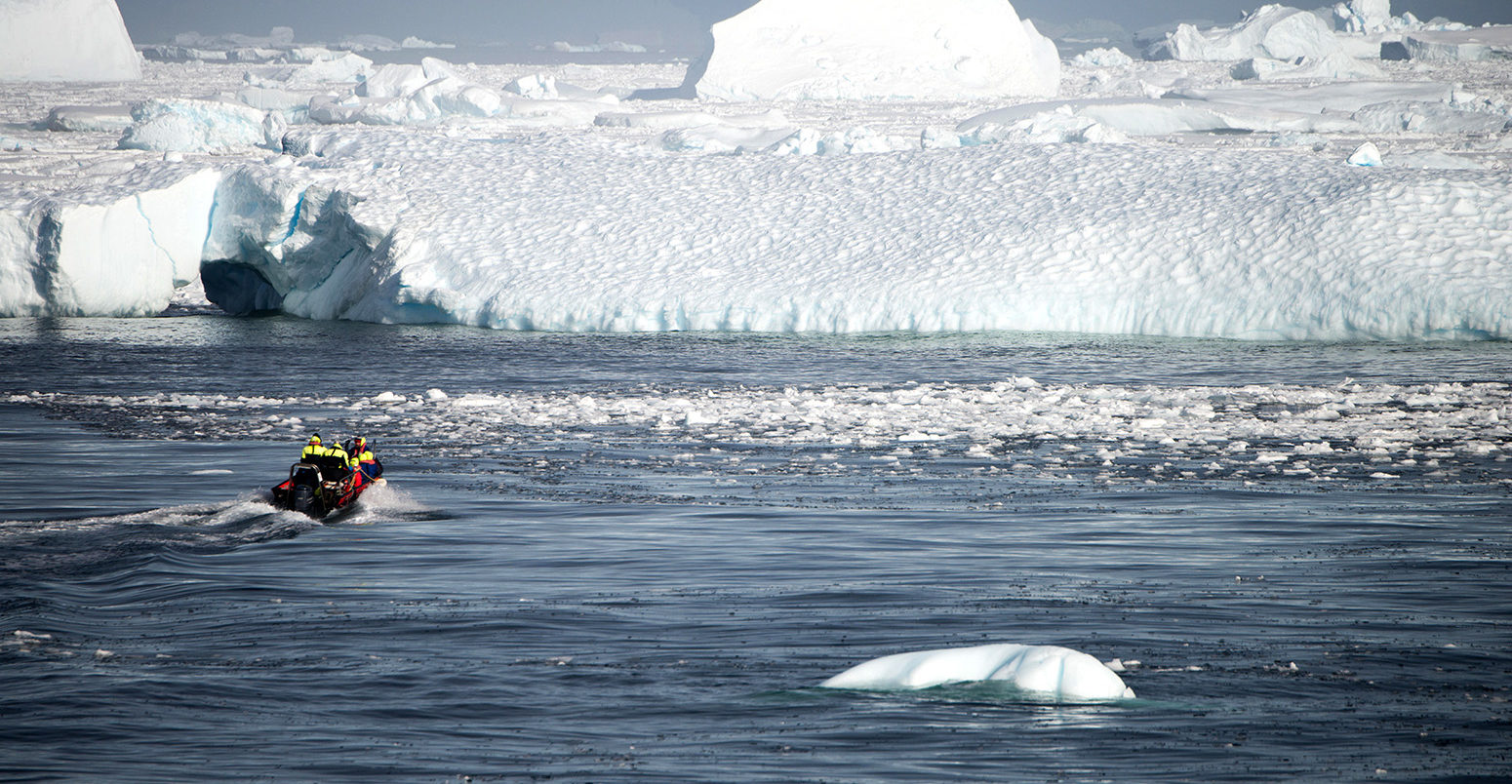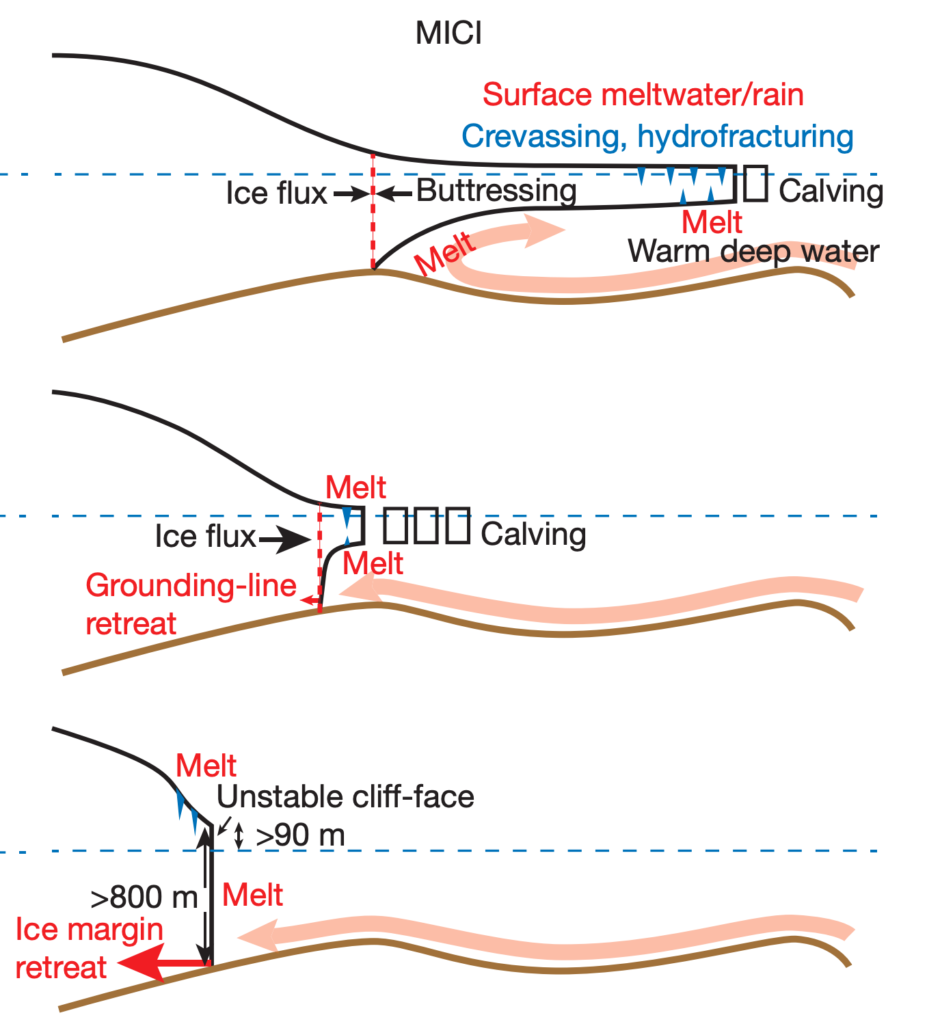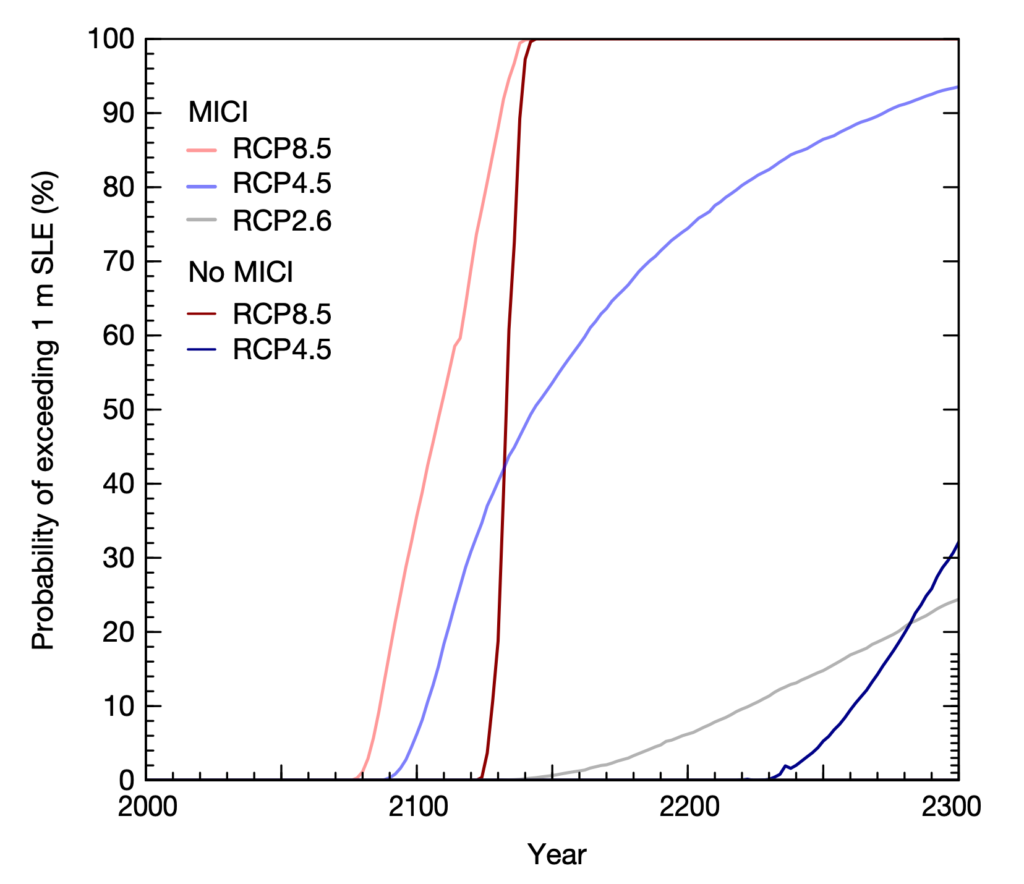
Studies shed new light on Antarctica’s future contribution to sea level rise
Robert McSweeney
02.06.19Robert McSweeney
06.02.2019 | 6:00pmA widely reported study in 2016 that suggested Antarctica could add more than a metre to sea levels by 2100 was likely an “overestimate”, new research says.
The original study, published in Nature, grabbed headlines with the finding that Antarctic ice was at risk from “marine ice-cliff instability”, which would see towering cliffs of glacier ice collapse into the ocean under their own weight.
A new Nature study revisits the theory, finding that the “jury’s definitely still out” on ice-cliff instability coming into play this century, the lead author tells Carbon Brief.
A second paper, also in Nature, says that melting of the Greenland and Antarctic ice sheets could have dramatic knock-on impacts for the climate. These include the potential weakening of the Atlantic current that brings warm water up to Europe from the tropics, and a positive feedback loop that reinforces melting of Antarctic ice.
The papers together suggest a likely contribution of around 15cm from melting Antarctic ice by the end of this century, with a 5% likelihood that it will exceed 39cm under a high-emissions scenario.
Rising seas
Global sea level rise is simultaneously one of the most certain and uncertain impacts of climate change.
On one hand, scientists know that sea levels will rise as the climate warms and then continue for centuries, even after global temperatures have stabilised.
On the other, however, there are sizeable question marks over the likely size and rate of sea level rise contributions from the Antarctic and Greenland ice sheets, which together hold enough ice to raise sea levels by tens of metres.
In 2016, a new study was published in Nature that caused quite a stir. It suggested that a previously unconsidered process, known as “marine ice-cliff instability” (MICI), meant the glaciers in the Antarctic were more unstable than scientists had thought. The paper concluded that “Antarctica has the potential to contribute more than a metre of sea level rise by 2100 and more than 15 metres by 2500”.
Just a few years previously, the Intergovernmental Panel on Climate Change’s (IPCC) fifth assessment report had estimated the likely contribution from the Antarctic ice sheet of between -6 and +12cm by 2081-2100 (pdf).
The 2016 study generated a lot of media coverage, even making the frontpage of the New York Times under the headline: “Ice sheet melt seen harming cities by 2100”. Such was the scale of press attention, it became the most talked-about climate paper of that year.
Almost three years on, a new study – also published in Nature – has revisited the 2016 paper and undertaken further statistical analysis. The new findings question whether there is sufficient evidence to support MICI playing a role in sea level rise this century.
Ice-cliff instability
The quintessential video clip of a melting glacier shows a large chunk of ice breaking off its face and plunging into the sea. This process, known as “calving”, occurs due to a combination of the glaciers’ slow creep forward and the rifts that cut through the brittle ice. With a thunderous crack, unstable pieces of ice break off, depositing icebergs into the surrounding waters.
Marine ice-cliff instability is a similar process, but on a colossal scale. The theory goes that where the height of a glacier face exceeds around 100m above the ocean surface, the cliff will be too tall to support its own weight. It will, therefore, inevitably collapse, exposing a similarly tall cliff face behind it, which, too, will collapse, and so on.
At the moment, calving of ice cliffs “isn’t widespread on Antarctica”, says Prof Robert DeConto, a professor in the department of geosciences at the University of Massachusetts, Amherst and co-author of the 2016 Nature paper. This is “because most of the very thick ice reaching the ocean is supported by buttressing ice shelves”.
This is where ice shelves – floating tongues of ice that flow out onto the water where a glacier meets the ocean – act to hold back, or “buttress”, the ice behind them. However, “many of Antarctica’s ice shelves are thinning in response to warm subsurface water temperatures”, DeConto tells Carbon Brief:
“If the ice shelves are lost, tall ice cliffs will become exposed, stresses at the edge of the ice will increase, and the ice will begin to break like it is in Greenland – or possibly even faster. That’s the concern. The loss of ice shelves is what sets this in motion.”
The illustration below, from the 2016 paper, shows how the loss of an ice shelf allows warm water to reach an unstable cliff face, speeding up the melt and retreat of a glacier.

Illustration of the marine ice-cliff instability process. The top stage shows the “buttressing” effect of the ice shelf, which is then weakened in the middle stage as the ice shelf disintegrates, leaving the cliff-face of the glacier exposed to warm ocean water in the bottom stage. Source: DeConto & Pollard (2016)
DeConto cites examples from Greenland as “the closest analogues of MICI in action today”. The one kilometre-thick Jakobshavn glacier – among the fastest flowing glaciers in the world – is calving “at a frightfully rapid pace”, he says, which is equivalent to “a horizontal rate of ice loss of around 13km per year”. He notes:
“If the pace of calving observed at Jakobshavn were to become widespread around the edges of the vastly bigger Antarctic ice sheet, it could cause very fast sea level rise. This is the take home message from our 2016 paper and that basic conclusion remains unchanged.”
In that 2016 paper, DeConto and his co-author, Prof David Pollard of Penn State University, used an ice sheet model to ascertain how periods in the Earth’s history that were only slightly warmer than today managed to have sea levels that were many metres higher.
Simulating the Pliocene, around three million years ago, and the Last Interglacial, 130,000-115,000 years ago, DeConto and Pollard found that the high sea levels from those periods could only be recreated when MICI was included. DeConto explains:
“One key point is that including these brittle processes in ice sheet models is the best way we’ve found to reproduce the high sea levels we see in the geologic past.”
Turning their attention to the future, DeConto and Pollard ran model simulations calibrated on their findings for the past. They found that including MICI “greatly increases the pace of future sea level rise in high greenhouse gas emissions scenarios”, says DeConto.
Model runs
![]()
The new paper revisits these estimates. It uses a statistical model, called an “emulator”, to replicate the model created by DeConto and Pollard. This allowed the researchers to expand the number of model simulations they ran to explore the full range of possible future outcomes – including those that do not include MICI – as well as calibrating the model with satellite data.
In simulations with MICI, the “most likely” model outcome under the high-emissions RCP8.5 scenario is a contribution from Antarctica of 45cm by 2100, says lead author Dr Tamsin Edwards, a climate scientist and lecturer at King’s College London. She tells Carbon Brief:
“This is much lower than the mean values in DeConto & Pollard – interpreted by many as the most likely values – which ranged from 64cm to 114 cm.”
But their findings also suggest that MICI was not necessary to produce the sea level rise seen in the Pliocene or the Last Interglacial. Without MICI, their most likely contribution from Antarctica is 15cm by 2100 under RCP8.5, with a “likely” range of 13-31cm. There is just a 5% likelihood of Antarctica contributing more than 39cm to sea levels by 2100, Edwards says:
“This brings the DeConto and Pollard projections well into line with previous studies for this century, which have upper bounds of around 30-40cm under high warming scenarios.
“I would say we consider these to be more robust, because there just isn’t enough evidence for MICI, or the simple way it is represented in their model.”
The chart below shows the likelihood of Antarctica exceeding one metre of sea level rise in the new simulations. It includes three emissions scenarios: low (RCP2.6, grey), intermediate (RCP4.5, blue) and high (RCP8.5, red), with and without MICI. The lines show how the probability changes through time.
So, for example, under high emissions with MICI, the likelihood of more than one metre of sea level rise from Antarctica emerges above zero around the 2080s, and rapidly increases until it becomes a certainty (within the model) in the 2130s. Without MICI, there is no risk of one metre of sea level rise within this century, but it does emerge relatively early in the 22nd century.
Only RCP2.6 – which is broadly consistent with the long-term goals of the 2015 Paris Agreement – is the only scenario “to ensure a low probability of high sea level rise”, the paper notes.

Projected probability of the Antarctic sea level contribution exceeding one metre out to 2300. Lines show three scenarios: RCP2.6 (grey), RCP4.5 (blue) and RCP8.5 (red), with and without MICI. Source: Edwards et al. (2019)
Jury’s out
The findings of the new study show that “the jury’s definitely still out on MICI”, says Edwards. There is a real lack of published studies that incorporate the process, she says, adding: “We really need much higher resolution models to try including it, which test different representations.”
However, it certainly “does not mean that MICI is irrelevant and must be forgotten”, says Dr Cyrille Mosbeux, a postdoctoral scholar at the Scripps Institution of Oceanography who was not involved in either study. He tells Carbon Brief: “We still need to take account for as many processes as possible” in sea level rise estimates.
As “very little is known about MICI and it is hard to predict its effect in the future”, the new findings emphasise the need for improved models and continued observations around Antarctica, he adds.
While the study does “illustrate the need for more in-depth analysis than we originally applied to our 2016 model”, says DeConto, he is concerned that the new findings “will be interpreted as evidence that marine ice-cliff calving doesn’t happen and is not a potentially dangerous driver of rapid ice loss and sea level rise”.
DeConto and Pollard are also currently revisiting their 2016 results in a new paper. DeConto says he is not able to comment on it directly as it is undergoing peer review. However, he has presented some preliminary results at the Fall Meeting of the American Geophysical Union (AGU) in December.
An article published in the Atlantic shortly afterwards reported that DeConto and Pollard “have lowered some of their worst-case projections for the 21st century” after making improvements to their model. The results are likely to put Antarctica’s contribution to sea level rise in 2100 at “about a foot” (30cm), the article says, which is “much closer to projections made by other glaciologists”.
Considering the theory of MICI was proposed less than eight years ago, it is still very early in terms of refining the estimates of what impact it could have. However, as scientific disagreements go, this is definitely the more cordial kind. Both DeConto and Pollard were originally co-authors on the new paper. They later recused themselves because they felt the results coming from Edwards’s statistical model were not consistent with what they were seeing from their own physics-based glacier model.
In addition, Edwards says the pair have been “very supportive and helpful with this work”, including running extra model simulations that she needed for her own statistical model.
Wider implications
In the second Nature paper out today, also co-authored by Edwards, researchers consider the wider impacts of ice sheet melt from both Antarctica and Greenland.
Climate models typically include “a dynamic atmosphere, ocean and sea ice, but do not consider changes in ice sheet size and volume”, explains an accompanying Nature News & Views article written by Dr Helene Seroussi from Caltech’s Jet Propulsion Laboratory.
This is because ice sheets tend to change on very long timescales and so are “assumed to have no effect on other components of the climate system for simulations that cover a few centuries”, says Seroussi. The new study does include these dynamic responses, by modelling the impacts of the influx of meltwater from ice sheets into the oceans.
The findings suggest there could be far-reaching consequences. For example, freshwater flooding into the North Atlantic from the Greenland ice sheet is projected to cause a gradual slowing of the “Atlantic Meridional Overturning Circulation” (AMOC), a perpetual conveyor belt that transports heat from the equator up to the North Atlantic. Under the high-emissions RCP8.5 scenario, “a gradual slowing in the first half of the century steepens after 2050”, the paper says, leading to a 15% weakening over 50 years.
In the southern hemisphere, the study finds that meltwater from the Antarctic ice sheet could “trap warm water below the sea surface”. This could create a positive feedback loop where the trapped warm water enhances melting of Antarctic ice shelves, leading to greater loss of ice.
This has implications for sea levels. The study projects a combined contribution of 25cm to global sea levels by 2100 from Antarctica and Greenland.
The findings suggest a larger contribution from Antarctica than the IPCC’s fifth assessment report (AR5), explains Dr Nick Golledge, associate professor at Victoria University of Wellington’s Antarctic Research Centre and lead author of the paper. He tells Carbon Brief:
“AR5 gave mean contributions for 2081-2100 of 4cm from Antarctica and 12cm from Greenland. In our new study, we suggest 14cm from Antarctica and 11cm from Greenland at 2100, so an increase to the Antarctic term and just above the upper bound of the AR5 uncertainty range (-6 cm to 12 cm).”
As these projections do not include MICI, they are comparable to the 15cm “most likely” projection from the MICI study.
Despite using different approaches, the two new sets of findings “show relatively good agreement”, says Cyrille Mosbeux, with both forecasting an Antarctic contribution to sea levels of “up to a few tenths of centimetres…which agree more with other studies”.
The two studies “demonstrate that polar ice sheets will have a crucial role in Earth’s climate in the future”, concludes Seroussi’s commentary article, “and highlight the need to explore the two-way coupling between the ice sheets and other climate components”.
Edwards, T. L. et al. (2019) Revisiting Antarctic ice loss due to marine ice-cliff instability, Nature, doi:10.1038/s41586-019-0901-4
Golledge, N. R. et al. (2019) Global environmental consequences of twenty-first-century ice-sheet melt, Nature, doi:10.1038/s41586-019-0889-9
Seroussi, H. (2019) Fate and future role of polar ice sheets, Nature
-
Studies shed new light on Antarctica’s future contribution to sea level rise

